#augusta hawkins
Note
Do you know if dowries for wealthy families were usually predetermined standard amounts, or whether it was some function of income / number of daughters?
Looking at Pride and Prejudice alone, it seems that it’s about (income x 3) / # daughters: Mr. Bennet’s 2000 gives each girl about 1000 pounds, and Darcy’s 10,000 gives Georgiana 30,000.
I feel like that’s the wrong way to go about calculating a dowry, since I’m sure if Darcy had another sister she would also get 30,000, but I’m not sure how it was done, and some (light) research didn’t help.
Short answer: it seems like many women’s fortunes are made up of their mother’s former dowry, split between them. This may be added to, but the wealthiest unmarried women in Austen’s novels are usually from small families (or have few sisters), meaning less division of the original fortune took place.
Long and kind of rambly Answer:
First, we must remember that the #1 rule of Jane Austen finance is Never Spend the Principle. These people for the most part are living on the income of generational wealth. A good portion of this wealth is in land, but some is in investments. They never spend that money. (Also, a lot of the time, they literally can’t spend the principle, it’s in trust and protected by legal agreements)
When a woman marries, her fortune can be, and it seems like often is, preserved for her children in the marriage articles (legal agreement made at the time of marriage, similar to a will). We see this with Mrs. Bennet. She brought £4000 into the marriage, one additional thousand must have been supplied by the Bennet family, resulting in a safe £5000 for the mother and daughters. Now if Mr. Bennet was prudent, he could have reinvested the income on that fortune, resulting in very healthy dowries for his own daughters, but if course he didn't. (I have a whole post about that here)
Now here is an interesting point, the £5000 set aside for Mrs. Bennet and her daughters is not already divided. This means if the Bennets wanted to tempt a man to marry one of their daughters, they could offer the full £5000 as one daughter’s dowry. However, that isn’t what we see most commonly in Jane Austen’s novels; we see equal division. But we do see many fortunes that are not released until the death of both parents.
For example, here is Anne Elliot’s fortune: “a small part of the share of ten thousand pounds which must be hers hereafter”. Anne’s dowry is most likely in trust, unable to be touched by her father. However, the wedding articles probably give him a life interest and since he needs the income, she doesn't get it right away. Anne will probably get her money upon her father's death. This amount is most likely Lady Elliot’s dowry, divided between her daughters. Henry Tilney is getting a similar inheritance: Of a very considerable fortune, his son was, by marriage settlements, eventually secure. But it does not go to Henry until his father dies. John Dashwood inherits a similar fortune from his mother.
You can see here why it’s a problem if you marry someone who is penniless and you don’t have a big income! Mr. Bennet doesn’t have a big fortune to start with so he really, REALLY needed to save...but even Darcy is going to have to be prudent to give his daughter’s sufficient fortunes down the road having married the poor Elizabeth Bennet. Marrying for wealth wasn’t only greedy, it’s about maintaining this generational wealth. If too much leaves in dowries, you get into trouble. Or you have to provide less money and your daughters don’t marry as well as you desire.
Some of the large dowries we see are from trade: Caroline Bingley’s 20k, Sophia Grey’s 50k (the future Mrs. Willoughby), and Augusta Hawkins’s 10k (the future Mrs. Elton). Lady Middleton and Mrs. Palmer are the daughters of a tradesman as well. This is important because this money is new, which a lot of old families desperately needed after getting into debt. Many properties were entailed, meaning they could not be sold. If you got into debt, it was hard to get out because you can’t sell anything. And for families in trade, well-educated and wealthy daughters had a good chance of marrying up.
So, Georgiana Darcy’s fortune may well be the money that Lady Anne brought into her marriage. Importantly, Georgiana is an only daughter. I actually doubt if she had a sister that they would both have 30k, they might have 15k or 20k each. The wealthiest women we see come from very small families, like the wealthy Caroline and Louisa Bingley, Emma and Isabella Woodhouse, Anne de Bourgh, and Miss Morton, the only daughter of Lord Morton (S&S). Even Agusta Hawkins is one of only two children. Which makes sense because it’s hard to save, but it’s easy to just take the dowry and pass it on, which if you are an only daughter works out great. If you are Catherine Morland it might not work so well.
Further reading (though I must note this article has a misquote from P&P)
Also, Wives & Daughters by Elizabeth Gaskell really gets into the problem of generational wealth and gentry slipping into poverty. Makes for an interesting study (The Hamleys of Hamley are the family)
95 notes
·
View notes
Text
A: The Entertainers Pt 2
Andrea Bordeaux Actress | Andrea Lewis Actress | Anesha Bailey Actress | Angel Coulby Actress | Angel Haze Rapper | Angel Parker Actress | Angel Theory Deaf Entertainer | Angela Bassett Actress | Angela Lewis Actress |
Angela Meryl Stuntwoman | Angela V. Shelton Comedienne | Angelica Joy Model | Angelica Ross Actress/Activist | Angelique Noire Model | Angelique Perrin Voice Actor | Angely Gaviria Colombian Actress | Aniela Gumbs Child Star | Anika Noni Rose Actress | Anita-Joy Uwajeh Actress | Anjela Lauren Smith Actress | Anjelika Washington Actress |
Annarah Cymone Actress | Ann Ogbomo Actress | Ann Wolfe Professional Boxer/Actress | Anne Amari Adult Entertainer | Antoinette Robertson Actress/Model | Antonia Thomas Actress | April Bee Blogger | April Kae Musician | April Weeden-Washington Stuntwoman |
Ariel Alexandria Davis Actress | Arlene Hawkins Model | Armelia McQueen Singer | Ashanti Singer/Songwriter/Dancer/Actress | Ashlee Blackwell Writer | Ashleica Edmond Actress/Voice Actor | Ashleigh Morghan Model/Actress | Ashleigh Murray Actress | Ashley Blaine Featherson Actress | Ashley Madekwe Actress |
Ashley Nicole Black Actress | Ashley Nicole Williams Actress | Asjha Cooper Actress | Asmara Blogger | Assa Sylla French Actress | AsToldByKenya Blogger | Aube Jolicoeur Model | Aude Legastelois Actress | Audra McDonald Actress/Singer/Theater | Augusta Savage Sculptor |
Aunjanue Ellis Actress | Aurora Burghart Actress | Ava Duvernay Director | Awar Mou Model | Aweng Chuol Model | Ayisha Issa Actress | Ayo Edebiri Actress/Voice Actor |
#Black Actresses and Female Entertainers Masterlist#Black Actresses#Black Women in Entertainment#blackfemmecharacterdependency#black women entertainers#tags masterlist#tags#A-Z#A#A: The Entertainers#A: The Entertainers Pt 2
2 notes
·
View notes
Text
Brooksville, Florida

Quick Brooksville, Florida History
Brooksville, Florida was originally known as Melendez and then Benton. Incorporated in 1856, it is a wonderful city featuring a hilly terrain that ranges in elevation from 175 to 274 feet. There is a long history of successful planters, growers, and cattlemen in and around Brooksville.
Its southern background is reflected in its name, honoring South Carolina Congressman Preston Brooks who is best noted for hitting abolitionist Senator Charles Sumner on the head with his cane.
Brooksville's downtown area features the iconic Hernando Courthouse, along with great shopping in unique stores featuring everything from antiques, outfits, high-end resale, stationery, flowers and bric-a-brac to formal gowns – and stationery. Some streets still show the Augusta bricks laid by hand.
Florida Wildlife Corridor Foundation mural painted by Justin Alsedek is on Brooksville's City Hall building, which houses a free art gallery upstairs.
Things to Do in Brooksville, Florida
There are several downtown restaurants and coffee shops, along with legal and banking offices, a library, and more than one park. Brooksville has been working hard to revive its downtown to attract more visitors and became a Florida Main Street community in 2016.
For those looking for things to do in Brooksville, the Main Street organization holds several events in Brooksville's downtown area as well as farmers and artist markets, and a simply magical holiday celebration of all things Christmas during December with everything from musical trees to performing artists, decorations galore and horse-drawn carriage rides.
Local art is displayed in several downtown businesses and buildings, as well as murals painted throughout the downtown area. A walking tour map of the downtown murals may be found here.
The Brooksville City Hall building houses a changing art exhibit in Gallery 201, and all are welcome. There is no charge.
The architecture is interesting in several buildings and when looking for things to do in Brooksville, Florida, a wonderful historic walking tour can be had for the simple act of following the map here. If you would like more information about each building on the historic tour, download the complete guide here. (Please note that the Hernando Chamber of Commerce has moved to Brooksville's Tampa Bay Regional Airport. The guide is dated, but the history and map are accurate.)
Historic homes are throughout the downtown area and a tour has been mapped out. There are two B & Bs, including this one, known as the Mirador.
Another popular thing to do in Brooksville, Florida, is to visit the May Stringer Museum, located at 600 West Jefferson. Housed in the 1850 Stringer House, a Queen Anne masterpiece with a four-story tower, this historic building is reputed to be haunted. There are daily tours Tuesday - Saturday led by docents and the price of admission is only $10 for adults, $5 for children, free for those under 6 years of age, but the exhibits seem more adult-friendly.
F. L. Stringer was a State Senator and judge. With thousands of historic artifacts and regular tours, it commemorates the Civil War era and provides a glimpse at the lifestyle and relics of a gone but not forgotten segment of American history. Ghost tours are held on Friday and Saturday nights by reservation.
The May Stringer House houses a historical museum that is well worth a tour in Brooksville. It is said to be haunted.
In addition to the May Stringer house there is a historic train depot to visit. Next to the historic train depot museum is a one-room schoolhouse to visit on Russell Street. Both of these museums are adjacent to Russell Street Park which has the Good Neighbor Trail running through it.
The Good Neighbor Trail is a paved, multiuse trail that runs about 10.3 miles to connect with the Withlacoochee State Trail.
Continue east to find another wonderful shopping area, featuring the Hawkins House and the Florida Cracker Trading Company and Tap Room. There is even an old-fashioned Coney Island where it is rumored that Elvis Presley may have eaten many years ago with an ice cream shop in front.
The Florida Mermaid Trail
In 2020, a Mermaid Trail was created in downtown Brooksville, which is part treasure hunt and part walking tour. It is an easy activity for one or more to get out and enjoy the historic brick streets and well-kept homes and businesses. Each February, a Mermaid Festival is held in Hernando Park, where residents and visitors compete for the best-dressed mermaids, with and without their pets, and meet the real mermaids of Weeki Wachee Springs State Park. The maps for the Mermaid Trail can be found at Florida's Adventure Coast Visitor Center, adjacent to the park.
Expanding Beyond Brooksville’s City Limits
You may want to travel north on US 41 to visit the historic Chinsegut Hill Historic Site and rediscover the magic that caused its last private owners to name it Chinsegut, meaning, “a place where lost things are found.” Learn their story of courage and civil rights for all, as well as a historic timeline of occupation during significant national events. And it's beautiful and somewhat magical.
*Please note that Chinsegut Hill Museum is managed by the Tampa Bay History Center and is open on weekends for tours, as well as some outdoor events on select weekdays. An Emancipation Celebration is held in May.
Originally constructed in the early 1800s, and then added onto by subsequent owners, the Chinsegut Manor House was renovated in 2013-2014 and has been restored to the splendor of its glory days. Image by Diane Bedard.
Don't forget the Ice Cream
Head back south on U.S. 41 and then travel east on S.R. 50/U.S. 98. Make a right on Spring Lake Highway (541) and follow it to the top of the hill. On the right is Boyett’s Grove Citrus and Timeless Attraction. Here you will find a wonderful animal park where you can feed the animals, a dinosaur cave, taxidermy museum, birds, snakes, an alligator named, "Elvis", and more.
A putt-putt golf course winds through part of this fun-filled tourist trap. There’s even a snack bar, ice cream parlor, and an old-fashioned Florida gift shop! It’s one of my favorite places on the Nature Coast.
Read the full article
0 notes
Text
The Elton Family Album: Volume II

Augusta Hawkins is not a happy woman, which is perhaps not entirely surprising, given that she’s dead.
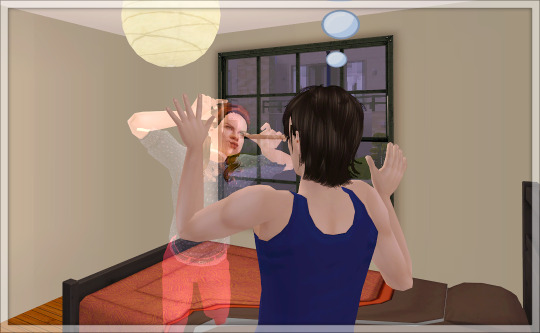
She doesn’t hold back on letting ex-fiancé and ex-housemate Philip Elton know exactly how she feels.

Philip decides it’s high time to lay Augusta’s ashes to rest at the Merybury Woodland Cemetery, which leads to a rather fortuitous meeting with total babe Ellen Frost. (And much inappropriate swooning, given the circumstances.)
Ellen is a final-year student at De Bourgh University, and quite why she’s hanging around at a cemetery rather than studying for her upcoming finals is never satisfactorily explained.

Philip is conscious of his responsibilities at home, including tossing adopted daughter Selina into the air...
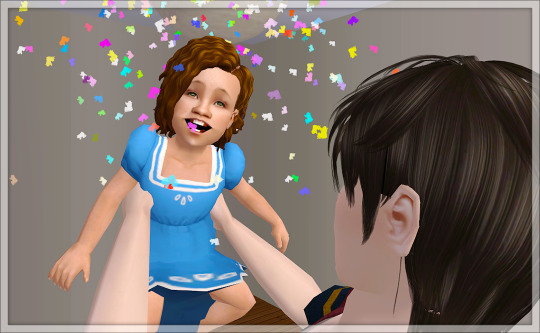
...so that she can age up. Look at that adorable face - a lot like her biological father, Frank Churchill, I would say!
Selina’s toddler stats:
~ Gemini 6 / 8 / 5 / 3 / 2
~ Brave / Sailor
~ OTH: Sport

But, he really can’t let the opportunity to get to know Ellen better slip by - three bolts!

Crushes all round.

Selina is absolutely fine, believe me, just unused to not being the centre of her dad’s attention!

A babysitter is engaged for date number two, where things progress rather swiftly, and they discuss the possibility of Ellen moving in with Philip after she graduates.



In fact, they progress very swiftly indeed!
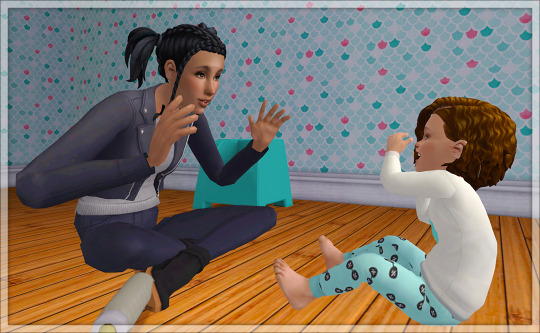
Ellen is a graduate before she knows it, and her first task is to get to know her new step-daughter Selina. (She did this autonomously, immediately after moving in!)
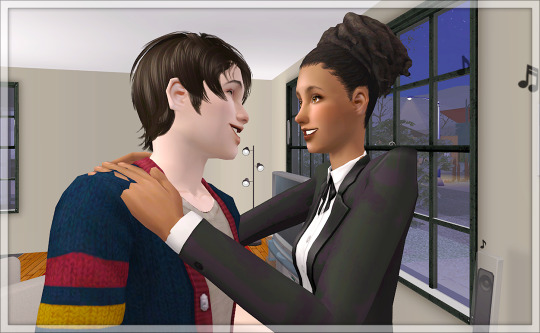
Then, to give herself a little makeover, more befitting an up-and-coming professional.
Ellen’s stats:
~ Aries 6 / 8 / 7 / 2 / 2
~ Brave / Hot-Headed / No Sense of Humour / Flirty / Schmoozer
~ OTH: Sport
~ Favourite Colour(s): Black
~ Aspiration: Fortune / Romance
~ Turn-ons/off: +Influential / +Hard Worker / -Blonde Hair
~ Major: Economics
~ LTW: Become The Law

And then to get pregnant herself! Ellen, what happened to all your ambitious career plans?!

She gets in some parenting practice with Selina. (Despite her Aspiration, she is a very attentive step-mum.)

Thankfully, everything goes smoothly for the birth, and we can say hello to their firstborn - a son, named Ambrose!

Curse the fertility of youth (she is rather younger than Philip)!

Those are possibly the chubbiest cheeks ever sported by any Sim!
Ambrose’s toddler stats:
~ Taurus 5 / 8 / 7 / 6 / 5
~ Easily Impressed / Dog Person (lots of them in Merybury!)

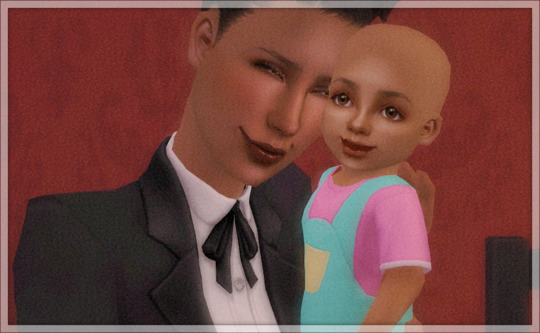
Ambrose is very soon joined by a younger sister, Olivia!

My name is Selina and I like mermaids.
~ Gemini 6 / 8 / 5 / 3 / 2
~ Brave / Sailor / Supernatural Fan
~ OTH: Sport
~ Favourite Colour(s): Aqua / Orange

These two get along really well. :)

Despite the rain setting in, Ellen takes Selina on a trip to the Sunshine Play Park, in their nightclothes. o.O
Selina of course - being a Brave Sailor - makes believe that she’s a pirate.

Ellen meets fellow sports fan and all-round sociable fellow Frederick Wentworth (he’s too polite to comment on Ellen being in her skivvies in public).

And Julia Bertram proves that you’re never too old for the simple pleasures in life!


Selina is a shoo-in for private school, where she starts as she means to go on, winning friends and influencing people, beginning with classmates Lucas Darcy and Louisa Willoughby.

Olivia’s toddler stats:
~ Scorpio 4 / 5 / 7 / 5 / 1 (this family is such a bunch of meanies!)
~ Ambitious / Vehicle Enthusiast

Cute as buttons!
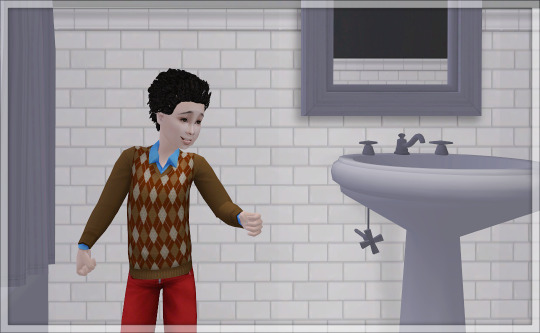
Toddlerhood soon comes to an end for Ambrose - again, in the bathroom (why, game, why?!)
~ Taurus 5 / 8 / 7 / 6 / 5
~ Easily Impressed / Dog Person / Supernatural Fan
~ OTH: Sport
~ Favourite Colour(s): Red / Brown

Oh boy, here we go again! How many times do I have to tell you - you’re not Family Sims?!
#sims 2#gameplay#merybury#elton family#philip elton#ellen frost#selina elton#ambrose elton#olivia elton#augusta hawkins#frederick wentworth#julia bertram#lucas darcy#louisa willoughby#louie willoughby#frank churchill
19 notes
·
View notes
Text
Noah catches up with One Piece (post-time skip up to #100): a summary
This is going to be long I’m so sorry
Franky now has light-up nipples? for reasons? (they’re very useful for deep sea communication, apparently)
you know what? Zoro does have a point when he says that Sanji is annoying (I still have a soft spot for the simp cook, though)
Brook is without any doubt my favourite (it’s the bone jokes. the godsawful skeleton puns. also love me a bard, no matter their level of wackyness)
not me tearing up every single time Ace is mentioned, no siree
lots of Law (can’t complain about this), not enough Bepo (this I do complain about)
speaking of Law, the man wears a hat all the time ‘cause his hair is illegal (it looks so fluffy everyone around him would try and ruffle it at any given moment- I know I would)
the average blood-related family has a ratio of 90% blazing garbage fires 10% genuinely good people (notable exceptions: every single royal family the Strawhats have helped so far. also the Boa sisters)
Cora 😭
Doflamingo and Elias Bouchard share the same core energy and no, I won’t elaborate on this
also pls consider: a Magnus Archives/One Piece crossover
Bartolomeo is an absolute muppet. a whole idiot. he’s so cute I can’t even
Sabo ☺️ (for the love of the gods Oda please stop hurting my sunshine child)
plans? who makes plans? plans are for losers
wow. the backstories went to some dark places, uh
Marco does look like a pineapple. but pointing it out is like, rude
everybody loves Robin, and if anyone even thinks about laying a single finger on her is going to be oh so very sorry (I wholeheartedly agree)
the older Charlottes are a combination of weird? and pretty!… and it surprisingly works (for the most part, anyway)
I’m adamantly against hunting down Devil Fruit users to get their powers, but by the gods I would love to have Mont d’Or’s
please tell Brulee I’d die for her
I have a *very normal* amount of feelings for the mochi man who am I trying to fool? I’m in love with Katakuri
is anyone going to point out that Sanji’s siblings are the One Piece equivalent of the sailor senshi but evil? no? ‘cause I’m gonna
yay! we have successfully acquired another responsible adult™️ (Jinbe has no idea what he signed up for)
who is my most hated character? is it Sakazuki? is it Blackbeard? no, it’s a child shaped turd named Charlotte Flambe
fuck the Cp0. seriously
you know what? while we’re at it, fuck all the higher spheres of the World Govt.
Fujitora trolling Sakazuki over technicalities? 10/10. sir, you just got my official seal of approval
*Basil Hawkins waltzes in* he’s pretty. huh *two pages later* nevermind. he hurt Bepo, Penguin and Shachi, he has to go
X Drake will for the foreseeable future be referred to as Dino Nuggies
who among the Beast Pirates thought that ‘all leather’ was a good idea for crew outfits? ‘cause it’s really not
*Big Mom falls overboard and down a huge ass waterfall of doom* oh no! anyways, we all agree that Katakuri will be the new captain, right? (Perospero does not, in fact, agree- but not out of love for the augusta genitrix, that is)
👏 give 👏 Killer 👏 a 👏 break👏
Kid’s actual power is making everyone around him act in the most idiotic way possible
did Big Mom forge an alliance with Kaido just to try and get dicked down by King? probably
“oh, yeah, we just sent Strawhat’s 1# Marine fan to apprehend the extremely powerful woman who has a raging crush on said Strawhat. they surely won’t bond over anything at all, it’s a 100% foolproof plan”
Yamato? sir? I’m looking respectfully
everybody wants Apoo’s head on a pike and I’m here for it
Bonus
a whole decade worth of material and we saw Shanks in like, 3 pages? what the actual fuck
#I will now *patiently* wait for 101#one piece#Noah loses their shit ‘cause fictional characters: the thrilling saga#Noah reads One Piece
10 notes
·
View notes
Text
2nd February: Mr. Elton returns to Highbury
Read: Vol. 2, ch. 4 (22); p. 117 ("and when Mr. Elton himself arrived" through to "he would bring his bride").
Read and comment on WordPress
Context
We know this occurs around a week after Mr. Elton’s engagement was first heard of in Highbury. Jo Modert places this in the “first week of February” (p. 57).
Modert also notes that Miss Hawkins and Mr. Elton’s hurried courtship and engagement (“The wedding was no distant event”) can be attributed to a desire to marry before the advent of the Lenten season on February 23 complicates or forbids the performance of nuptials (ibid.).
Readings and Interpretations
The Charming Augusta Hawkins
In the beginning of this section, we are told that “[t]he charming Augusta Hawkins, in addition to all the usual advantages of perfect beauty and merit, was in possession of an independent fortune, of so many thousand as would always be called ten”; Barbara Thaden writes that this “parody […] of the first sentence in the novel” marks Miss Hawkins out “as a parody of Emma” (p. 54).
Mr. Elton’s return brings more information about Miss Hawkins into circulation in Highbury, apparently initiating with the story that he tells Mrs. Cole. Claude Rawson considers this section at length in analyzing Emma’s narratorial strategy (which he writes of as “a subtle collective consciousness, in which the characters’ minds and motives interact with an authorial voice, who is in judgemental command of the report as a whole”; pp. 345–6). The passage makes various use of the language of an amused narrator, of novel slang, and of the register of gossip:
The language is that of the story-teller, not a neutral and merely factual narrator, but a commentator with a sharp personality of her own, knowing, amused, and sarcastic. When she speaks of Augusta’s ‘usual advantages of perfect beauty and merit’, as well as a fortune of sorts, she is partly glancing at a usual routine of novels, especially in romantic happy endings, where the bride does have ‘perfect beauty and merit’, and lives happily (as well as in solid material comfort) ever after. […] ‘The usual advantages’ sarcastically nods at romances, and how false and silly they ‘usually’ are, and intimates that real life, or the reality of this story, or both, are not like that, and particularly that Mrs Elton is somehow going to fall short of a romantically perfect heroine, which indeed she does.
But the passage only passingly evokes other fiction. […] As we read on, it is evident that Augusta’s perfect beauty, and merit, and wealth (which is, as we keep being reminded, a slightly nebulous entity) merge into another kind of consciousness. […] They are a kind of anthology, or digest, not necessarily verbatim, of everyday commonplaces of social gossip […]. The description partly gives the sense of feverish small-town babble […]. A generalised local opinion is thus manifestly included in the orchestration of voices which ostensibly or formally appears only as a narrator’s report. (pp. 343–4)
Similarly, Rachel Brownstein writes that “Austen the parodying ventriloquist” here
throws the voice of the whole community as it embraces the new Mrs. Elton […]. Noting the convenience of the round number—the precise amount that Meryton gossips say Mr. Darcy takes in a year—is a late variation on an old joke. Writing with awareness of what Jane Austen liked to call “the common phrase,” this author uses it to convey at once a convincingly human fictional voice and her own judgment of it. (p. 186)
Regarding the report of Elton’s courtship, Rawson writes that we are given not only “the ‘facts’, but Elton’s spin on the facts, and the narrator’s spin on Elton’s spin”:
Perhaps Elton mentions Augusta’s blushes, but it is Austen’s narrative voice that says the blushes were ‘with consciousness and agitation richly scattered’. The tart conclusion ‘that vanity and prudence were equally contented’ is Austen, not Elton, but her point is that this is how he, in his inner thoughts, rejoiced in the situation. Elton’s preenings are Austen’s sarcasms. The event is told through his eyes, but it is not exactly how he told it. […] The thing to take in is the fluid orchestration of perspectives, the author’s, the narrator’s, that of an implied group of gossiping neighbours, and that of individual characters, Mr Elton, perhaps, or even Mrs Cole, to whom he told his history. (p. 345)
The figure to which Miss Hawkins’ fortune is rounded—and our consciousness that it had most likely to be rounded up—represents a come-down from Emma’s thirty thousand pounds, as well as from the large family of young ladies of Elton’s boasting who had “twenty thousand pounds apiece” (vol. 1, ch. 8; p. 42). It also recalls us to Emma’s earlier supposition that Elton “only wanted to aggrandize and enrich himself; and if Miss Woodhouse of Hartfield, the heiress of thirty thousand pounds, were not quite so easily obtained as he had fancied, he would soon try for Miss Somebody else with twenty, or with ten (vol. 1, ch. 16; p. 88). Rawson writes:
A fortune ‘of so many thousands as would always be called ten’, ‘10,000 l. or thereabouts’, suggests that it is probably less than ten, but no one’s looking. The billowing fuss is conducted with a breezy good-enough-to-be-going-on-with satisfaction, as though the bluster, however supported by communal consensus, were running out of steam as soon as uttered, its impressiveness instantly undermined by imprecision. By the time we meet the future Mrs Elton, we are, with some inverse precision, aware that Mr Elton has had to lower his sights.
[…] Elton is vain, ambitious, and greedy. He gets what he wants, more or less. And yet this isn’t what his author thinks would be enough to satisfy any one who, unlike Elton, is vain, ambitious, and greedy in a way worth noticing […]. […] Elton is despised for his eagerness to rise in wealth and social standing, but also because his wealth and social standing are low, because his pickings are small, because he is easily satisfied. I think we cannot easily be sure that Austen wouldn’t like him better, or dislike him less, if his standing were higher and if he didn’t need to push. This kind of uncertainty is a signature of the novel. (pp. 347–8)
Miss Hawkins’ reasons for acceding to the match were also presumably based in ambition, married women in general occupying a more prominent social position than their unmarried counterparts. In keeping with the story of her courtship, Margaret Doody argues that Miss Hawkins’ last name constitutes a hunting metaphor:
“The charming Augusta Hawkins” arrives in midnovel; a woman from the Bristol area searched successfully for a husband in Bath. […] “Hawkins” derives from Anglo-Saxon hafoc, or hawk, relating to the elite practice of hunting with a hawk or falcon. This lady is “a little hawk,” or more correctly the descendant of someone who looked after a hawker’s little bird. Miss Hawkins descends like a hawk upon her prey, an eel from Eel-town [“Elton”] only too anxious to be caught. (p. 157)
The choice of the elevated “Augusta” contrasts with this surname (“the bird of prey or ugly saleswoman (‘hawker’) in conflict with a grandiose empress”) to “indicate[] the Hawkins family’s social climbing”: “The Hawkins parents […] had not caught on to the fact that upper-class people tended to shun ‘fancy’ or classical names, preferring tried-and-true names of monarchs and saints” (p. 166). B. C. Southam notes that “Jane Austen herself never calls people she is fond of by these fancy names, but reserves them for such female cads or cats as Lydia Bennet, Penelope Clay, Selina Suckling, and ‘the charming Augusta Hawkins’” (p. 268).
Discussion Questions
Who narrates this section? What can we learn about Miss Hawkins, Mr. Elton, Mrs. Cole, and the narratorial strategy of the novel from these passages?
Are we meant to see anything of significance in Augusta Hawkins’ name?
Bibliography
Austen, Jane. Emma (Norton Critical Edition). 3rd ed. New York: W. W. Norton & Company, [1815] 2000.
Brownstein, Rachel M. Why Jane Austen? New York: Columbia University Press (2011).
Doody, Margaret. Jane Austen’s Names: Riddles, Persons, Places. Chicago: University of Chicago Press (2015).
Modert, Jo. “Chronology Within the Novels.” In The Jane Austen Companion, ed. J. David Grey et al. New York: Macmillan (1986), pp. 53–9.
Rawson, Claude. “Showing, Telling, and Money in Emma.” Essays in Criticism 61.4 (2011), pp. 338–64. DOI: 10.1093/escrit/cgr018.
Southam, B. C. Jane Austen: The Critical Heritage, Volume 2 (1870-1940). London: Routledge (1987).
Thaden, Barbara Z. “Figure and Ground: The Receding Heroine in Jane Austen’s Emma.” South Atlantic Review 55.1 (January 1990), pp. 47–62. DOI: 10.2307/3199872.
14 notes
·
View notes
Text
“Bath was a setting for many novelists, with Austen and Tobias Smollett making particularly good use of the city—Austen in Northanger Abbey and Persuasion and Smollett in the very funny The Expedition of Humphry Clinker (1771). The city’s appearance in novels reflected the appeal of the new, the attraction of leisure, and its significance in social life. Bath was far from new as a settlement, going back to pre-Roman days, but it was new as an eighteenth-century experience, both as a place of leisure—indeed, the place of leisure—and as a new townscape made dramatic by its rise up an impressive hill.
By 1800, Bath had a population of about thirty-three thousand and was about the tenth largest town in England and Wales, although the numbers there fluctuated with visitors and therefore the season. Bath was scarcely unique as a fashionable spa; the town itself, as well as its waters, were a commodity to be visited and an image to be consumed. Thirty-four new spas were founded in England between 1700 and 1750 and even more in the second half of the century. Thus, Southampton, where Austen moved in 1806 and originally not associated with a spa, had its Chaleybeate spa. Moreover, among the spas, Tunbridge Wells had a major advantage over Bath due to its proximity to London.
It was the spa visited by Austen’s cousin Eliza in 1787, and, in Austen’s Lesley Castle, Tunbridge Wells, along with London and Bath, is where Margaret Lesley and Charlotte Lutterell might meet in 1792. But for having fourteen children, the Heywoods in Sanditon would have been able to afford “an occasional month at Tunbridge Wells . . . and a winter at Bath,” the combination indicating that spas could be complementary resorts as well as rivals. In Pride and Prejudice, Georgiana Darcy’s friends go to Scarborough. For a spa resort, Mrs. Elton suggests Bath or Clifton. If not London, the spas of Tunbridge Wells and Cheltenham are not “the country,” as Edmund Bertram notes. Nevertheless, Bath became the great spa where there was most to do and where you should be seen.
When Lady Anson visited Buxton in 1751, in contrast, she was bored and dissatisfied. Bath set out to make certain its visitors were neither. Although already successful, the development of Bath as a city of orderly leisure, and therefore a respectable and safe place to visit, owed much to Richard “Beau” Nash (1674–1761), who, in 1705, succeeded Captain Webster as the city’s second master of ceremonies. Nash’s “Rules” for the behavior of visitors to Bath were first published in 1707. This was part of the process by which the codification of social propriety was expressed and debated, explicitly or implicitly, in print. Novels were another aspect of this process, and the two combined in that, in fact and in fiction.
Health might be the basis of the resort, but Bath was often a destination for those seeking marriage, and this goal attracted visitors of all ages. This was the case for men and women of all ages wishing to marry and for the parents acting as chaperones for the young women. Once rejected by Emma, Philip Elton promptly sets off for Bath, where he goes to a full master of ceremonies ball, where prospective partners are introduced. The process works as intended, for his progress to an engagement with Augusta Hawkins is rapid: “the first hour of introduction had been so very soon followed by distinguishing notice . . . the rise and progress of the affair was so glorious—the steps so quick, from the accidental rencontre, the dinner at Mr Green’s, and the party at Mrs Brown’s—smiles and blushes rising in importance.”
Elton is a clergyman who stays at the White Hart, a large coaching inn, when in Bath. There was a strong clerical presence in the city, as it was the center of Lady Huntington’s evangelical “connexion” based on propriety chapels into which she placed Anglican chaplains. Augusta, once established in Surrey as Elton’s wife, recommends Bath’s waters to Mr. Woodhouse, only to be told that he had tried them without success. In a condescending manner toward Emma, Augusta goes on to draw attention to the city’s other, more social and matrimonial, attractions: “It is so cheerful a place, that it could not fail of being of use to Mr Woodhouse’s spirits, which, I understand, are sometimes much depressed. . . . As to its recommendations to you . . . the advantages of Bath to the young are pretty generally understood. It would be a charming introduction for you, who have lived so secluded a life.”
Emma was not impressed, but then Augusta is a caricature of misunderstanding and social solecism, indeed repeatedly so. Subsequently, Frank Churchill, with reference to the Eltons, comments on the misleading social show of Bath: “How well they suit one another!—Very lucky—marrying as they did, upon an acquaintance formed only in a public place!—They only knew each other, I think, a few weeks in Bath! Peculiarly lucky!—for as to any real knowledge of a person’s disposition that Bath, or any public place, can give—it is all nothing; there can be no knowledge. It is only by seeing women in their own homes, among their own set, just as they always are, that you can form any just judgment. Short of that, it is all guess and luck—and will generally be ill-luck.”
…The walks at Bath were major social attractions. By midcentury, Bath had a series of walks and gardens: the Gravel Walks and the Grove, Harrison’s walks and gardens, the Terrace Walk, the Parades, and the Spring Gardens. They were lined with luxury shops, assembly rooms, and socially acceptable accommodation. Alongside its development as a fashionable resort, the effects of such construction and activity helped make Bath an attractive topic and space for the descriptive poetry, prose, and painting of the period, as in Mary Chandler’s poem A Description of Bath (1733). Novels joined this trend.
Yet Bath also attracted moral panic, as did so many of the different aspects and sites of urban life in this far-from-secure age. As reflected in the fate of Eliza Williams, the city focused concerns about conduct and misrepresentation, both of which centered on the marriage market and thus sex. Countering perceptions of the city as a place for vice, notably gambling and sex, and the depiction of the worrying problems of luxury, the life of Bath was based on the fusion of gentility and equality. The assurance of the former made it possible, in theory, for the company to set aside status and act as equals, sidelining the concerns about social fluidity that played such a corrosive role in mixing and were actively encouraged by Beau Nash and later, in 1987, contributed to Bath being declared a UNESCO World Heritage site.
….Like the West End of London, Bath became normative as a setting for the urban play of the social elite through their repetition in novels, plays, and paintings. The town also had a rich cultural life, notably in music, and, in this respect, was more advanced than most other cities. Nevertheless, a poem printed in Swinney’s Birmingham and Stafford Chronicle on May 23, 1776, included criticism of a concert audience in Bath for not concentrating on the music, especially condemning a peer who talked during an excellent chorus.”
- Jeremy Black, “Bath: The Capital of Leisure.” in England in the Age of Austen
4 notes
·
View notes
Text
The Critique of Manners, Part II
~Or~
A Candid Review of ITV's Emma (1997)
Disclaimer: I do know that both this and the Miramax version were released in 1996, but to avoid confusion, I refer to this one as the “1997 Emma” in reference to the US release date.
The bones of this review were written some six years ago after my initial viewing. I’ve watched it three or four times since then, two very recently (Within the past year). I’d started to soften on it in the most recent watch. So many people love it so much I thought surely maybe I’m just crazy or even wrong; until I found this blog post from 2008 (a year before my favorite version was released) that hit on almost EVERY SINGLE thing that skeeved me out about this version when I first watched it.
Like my previous review of Emma. (2020), I’ll be covering the cast and overall handling of the script in comparison with what I know from reading the book. I will also be commenting on my thoughts about the costumes (Whether they are attractive or accurate, or both, or neither) which will be a bit more in depth than it was for the 2020 version, and this will set a pattern for the costumes section going forward.
Directed by Diarmuid Lawrence with screenwriting by Andrew Davies (Or should I say “Written by Andrew Davies with direction by Diarmuid Lawrence”?), this version was a fan-favorite among Janeites for many years for … well, reasons I’ve never been entirely certain of. I’ve read the book twice through and referenced pertinent passages MANY times besides, and really I don’t see what they’re raving about.
Let’s dive in.
Cast & Characterization
I’d known about this adaptation for a while, but I held off on watching it, largely for one reason: my apprehension about Mark Strong playing Mr. Knightley.
I was concerned because when I watched this I had already seen Mark Strong as Sir John Conroy in The Young Victoria and as Lord Blackwood in Sherlock Holmes, both very unpleasant characters. But there have been several occasions when I expressed displeasure with casting choices only to eat my words when I actually watched the movie. So I entered into watching this with an optimistic outlook, sure that Mark and Kate would surprise me with brilliant performances. And I would like to say that they did, but that would be an untruth.
My biggest fear about Mark Strong playing Mr. Knightley was that his rebuking of Emma was going to be a watered down version of ‘RAAAWWWRRR’ that I was familiar with, specifically because of The Young Victoria. It’s very hard for me to see Mark Strong point his finger in Emily Blunt’s face and shout at her, and then watch him do the same thing with Kate Beckinsale (only somewhat less aggressively) and expect to feel all warm and fuzzy about their romance. I expected that to be a tall order. And it was. Whenever he raises his voice, the right side of his face pulls up into a snarl. Now since it does this no matter what role he’s playing I’m guessing that’s just how his face is. It’s not his fault really and it’s almost certainly unintentional, but I’ve seen that snarl before and it does NOT belong on Mr. Knightley’s face.
Don’t ever think I don’t LOVE Kate Beckinsale, and I don’t necessarily think that my problems with this interpretation of Emma are her fault; these things very rarely fall on the shoulders of the actual actors, but those of the screenwriters and directors who guide them. However – and I am aware that this might sound a bit harsh – I would say that at points, Kate Beckinsale’s performance in this movie (In my opinion) barely outstrips community theatre or even very good high school drama club level acting. It seems to me that there’s burden on her here to sound historical or period. This lends to this interpretation of Emma feeling at once both cold and childish (more on that later.)
Her best moments are when she runs into Jane as Jane is leaving Donwell and when she speaks with Robert Martin at the end of the film. I always like scenes where Emma tacitly apologizes to Mr. Martin, and her feeling when she invites him to Donwell is Kate’s finest moment in this movie.
I found Raymond Coulthard’s Frank Churchill insignificant at first, but on repeat viewings I really started to hate him. I don’t think Austen intended Frank’s caddishness (to use more modern vernacular I’d say he’s an utter “Douche”) to be quite this obvious on first glance. He’s a creep in this version and Raymond Coulthard is just not at all attractive to me, from his big nose to his little shark teeth.
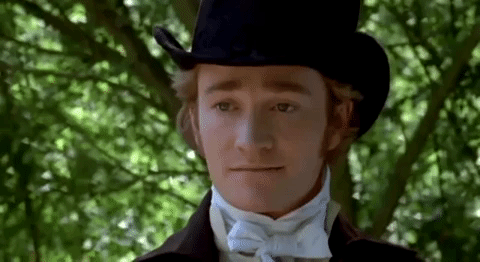
Olivia Williams was a good, even great, Jane Fairfax, and in my opinion does a much better job of portraying Jane’s vexation than, say, Polly Walker did (more on that next time), while still quietly looking like she’d like to arm-bar Frank rather than take his vulgar teasing lying down.
She also has the distinction of being the only Jane Fairfax who’s singing REALLY blows Emma’s out of the water, and I like that all of the songs she sings are in languages other than English (primarily Italian I think?). This achieves the double whammy of showing how much more accomplished she is than Emma by emphasizing that not only does Jane sing and play better, but she knows languages too.
Samantha Morton is a superb actress whom I love and I was sort of appalled at how she looks in this movie. Is she dying of a wasting illness? She looks like a gust of wind will carry her away, although since she looked the same in the 1997 Jane Eyre (In which she played the title role under similarly appalling direction) perhaps that was just her look that year?
Dominic Rowan, as Mr. Elton, is… there’s a perfect word to describe it and I just can’t think of it right now. Like every other young man in this movie (other than Robert Martin) he’s got this feeling of skeeviness to me but it’s more than that. It’s a dweebie-ness as well. This is so dissatisfactory to me because Mr. Elton is supposed to have every appearance of charm and agreeableness, with his only obvious fault being his over-eagerness to ingratiate himself to Emma and some rather vulgar locker-room type talk about marrying for fortune. He’s just so… (I’ve hit upon it now after some discussion with my sister) dingy. He looks less like a “very handsome young man” who “knows the value of a good income” and more like the kind of guy that scrubs up okay, but still you can tell from the rumple of his clothes and the pizzaroni odor wafting from him that he lives in his mom’s basement.
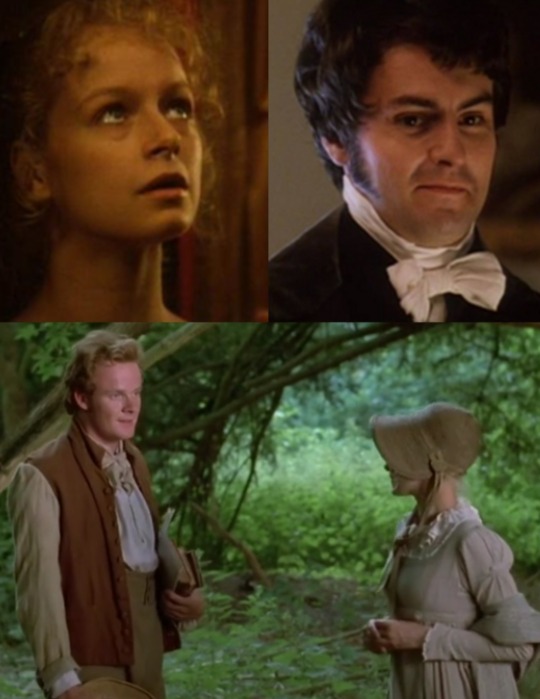
The shining star for me in this production was Alistair Petrie as Robert Martin. I love him as an actor and especially after watching him in Cranford, I think he was an excellent choice for Harriet’s Mr. Martin.
Davies wrote the character to be a little more romantic (Actually buying Anne Radcliffe’s The Romance of the Forest, where originally Mr. Martin was supposed to forget to – something Emma uses as a mark against him to prove how he will age into an “gross vulgar old farmer” who is “obsessed with profit and loss”.)
I especially like an inserted scene where Mr. Martin, working in his field, sees a distressed Jane Fairfax from afar as she is walking home (I think from Donwell). I thought it drew an interesting parallel between two emotionally wronged characters that otherwise would have no interaction.
What’s with Mrs. Elton (Lucy Robinson)? I don’t think nearly enough people question this. I’ve seen it explained away as her being from Bristol and trying to make herself sound more hoity-toity to hide the fact that she’s New Money. I’m not positive on what a Bristol accent sounds like (For that is where Augusta Hawkins is from) but… this sounds like an American trying to sound posh. At some points she almost sounds Texan. It’s all very confusing, because the actress is British.
Prunella Scales lists among her achievements being an outstanding actress and comedienne, as well as bringing into the world Samuel West, one of my all time favourite British screen crushes. She's probably best known for her work on Fawlty Towers, so its interesting to see her range as much less inscrutable Miss Bates. Her performance is by the book, but so much more engaging than Constance Chapman's 1972 offering, although i find her perhaps a shade too placid. She lacks a certain nervousness that I associate with the character (for more information, see my previous review.)
As for Bernard Hepton as Mr. Woodhouse, I can only say I. Didn’t. Like. Him. I have every consciousness of this being a personal bias. I have seen him play too many insufferable characters in too many things to like him as Emma’s lovable if tiresome father. This isn’t a knock on him or his performance; his reaction to Mrs. Elton is some great subtle visual comedy, this is just a me thing.
Another one of the better characterizations, though a relatively small role, is John Knightley. Played by Guy Henry, he is shown to be a good father, and an “Gentleman-like man”, with just the right blend of good humor and caustic comments.
Sets & Surroundings
I’d never paid MUCH attention to or questioned the houses and interiors used for estates in Austen adaptations until the 2020 version of Emma used such ridiculously lavish houses for relatively provincial gentry it forced me to sit up and pay attention. I think the houses used in this version are mostly suitable.
The part of Donwell Abbey’s exterior is played by Sudeley Castle in Gloucestershire. The Key words for Donwell from the text are “rambling and irregular” and while perhaps not as big as the Former Claremont House (Which, it is believed, was Austen’s inspiration for Donwell Abbey) it definitely is a suitable architectural style and situation and furthermore, having been purchased in the 19th century by a glove manufacturer and having been up to that point left in a little bit of a state of disrepair, fits the “neglect of prospect” Austen describes as well. Its interiors are a cobble-work of the Great Hall at Broughton Castle (Oxfordshire), various rooms at Stanway House (Gloucestershire), and the Strawberry beds at Thame Park (Oxfordshire)

(Top, left – Sudeley Castle; Bottom left – Trafalgar Park; Right – Dorney Court)
Trafalgar Park in Wiltshire and its interiors (a minty sage-green drawing-room fitting in perfectly with the mint-chocolate – primarily chocolate – color palette of the production) played the role of the Woodhouse’s home, Hartfield. A typical Georgian style house in red brick, I believe is consistent with Austen’s description of a “well built, modern house”.
Dorney Court in Buckinghamshire was used for Randalls, Mr. Weston’s recently purchased estate. It’s a Tudor style red brick house and it looks pretty on the mark from the front facade, but I think it’s still too big for a “small estate” with only two guest rooms (Although there’s no panic about the snow in this version – perhaps because it’s already snowing when they set out.)
My biggest problem is the lighting of this movie. I understand natural lighting and I LOVE it when you can even it out – but it is so dark in the evening scenes that it adds to the colorlessness of an already colorless production.
Fashion
Oh Jenny Beavan. You are a well-respected costume designer with good reason. However, I know that most of these costumes are rentals, but why is every-fucking-thing in this movie a shade of brown, beige or green?
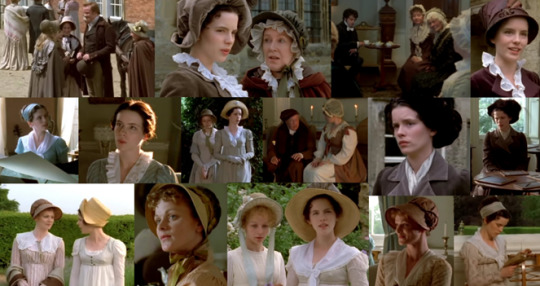
As you can see, a rich tapestry of brown and beige. And this isn’t selective. this is (just about) every day-wear outfit in the movie (barring repeats and a few exceptions that I’ll give mention to below.)
Emma’s outerwear is brought to you by Hershey’s Chocolate. Also I’m not certain but I think that her light brown redingote is the same one as Elinor’s in the 1995 Sense and Sensibility? If anyone can confirm, drop it in the comments.
Perhaps the evening wear will be more colorful?

Barely – Mrs. Weston in a brownish orange; Mrs. John Knightley in an orange-ish brown; Emma gets a dark blue? Or is that just the wintery glow from the window on a dark green velvet? Green (either so dark it’s almost black, or washed-out mint) appears to be the only color Emma is allowed to wear other than brown or ivory/white. Even her gown for the Crown Inn Ball (upper right) is an underwhelming and rather dingy ivory. The champagne number she wears for Christmas at Randalls is not only lack-lustre, but also sports what I’m now calling a “Bridgerton Bust” (where the Empire waist comes up too high, with the seam apparently resting across her bust rather than under it.)
The pink frock (seen properly only from the back) on Mrs. Weston is as close to real color as a main character gets in this production, and can be recognized as one of Jane Bennet’s dresses from the previous year’s Pride and Prejudice.
Even Jane Fairfax doesn’t get a break. Rather than putting her in Jane Fairfax Blue ™ (honestly, Jane Fairfax being costumed in blue is so consistent at this point Crayola should just name a crayon in her honor - this is gonna come back in future reviews) she gets a black-green evening number with no trim at all, and a succession of what the Ladies over at Frock Flicks like to call the “Dumpy Regency Little White Dress”, or drab gray-blues.
Some of the background dancers in the Crown Inn Ball scene get to wear pink! Why not put Harriet in a nice pink frock for this scene?! Why is this so difficult?!

Strawberry picking at Donwell is the only time main characters are consistently wearing identifiable colors that aren’t brown or green: Mrs. Weston in pink, Miss Bates in (oddly the most colorful dress of them all) a nice refreshing lavender blue; Jane gets grey/blue and Mrs. Elton, a pastel mint. Harriet is also given a little break in Mrs. Elton’s introduction scene in a (very) pastel blue frock, while Emma sports white (with a trademark green shawl.)
So how about the...
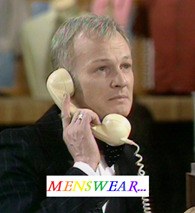
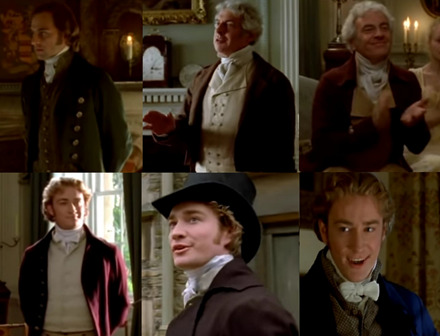
Similarly dull. I almost screamed for joy when I saw that Frank’s jacket was actually blue, and a vibrant blue at that. (The red is too close to brown, I’m sorry.)
So yes, in short the costumes, while perfectly technically accurate (I didn’t get a lot of caps of them but the trousers sufficiently tight, not that I care to look), are drab as a peahen.
As always I’ll outsource any dancing critique by linking Tea With Cassiane on YouTube, since I find her insights on the approach to dancing in Austen adaptations just fascinating and I would like to share such witty and informed reviews.
The Andrew Davies of it All…
*Strong Opinions Ahead*
There are so many reasons why this adaptation isn’t for me. First of all the very idea of making Emma, one of Austen’s most socially complex works (certainly her most vivid) into a sparse 107 minutes is baffling to me. Perhaps I can understand if it’s a Theatrical release but this is a TV production. Why not at least make it a two part special?
And besides the issue that, in order to make this fit the time frame, the story is severely truncated, there’s… the Andrew Davies of it all.
I have some issues with Andrew Davies’ screenwriting for this adaptation particularly. A LOT of issues. Where does one start? I think Knightley is a good place.
It’s not just the casting I don’t like here; but it does say something to me that they chose Mark Strong for this role. It’s a casting decision I discovered with disbelief when I first saw clips from this version in a Period Drama men compilation video on YouTube. I mentioned above that I know Mark Strong as unpleasant characters with man-handling habits. That’s the kind of role Mark Strong is associated with because that’s just what he does well. And I think this played into the casting here, because Davies’ interpretation of Knightley is a bit… fierce. He shouts SO MUCH in this movie and in scenes like the Harriet Smith debacle (where Mr. Knightley of the book even gets a bit angry with Emma) I can understand this, perhaps. But in the book Mr. Knightley takes many pauses to collect and calm himself, because his goal is not to quarrel with Emma but to argue a point. 97 Knightley takes no such pauses and spends the whole scene in what some might call an escalating rage.
Knightley’s cheerful arrival to Hartfield to tell Emma that Robert Martin intended to propose to Harriet is cut out so we start right off with his indignant exclamation of “She refused him?!” and it’s all go from there. To make matters worse, Emma’s own arguments are crippled by Davies’ editing. Many of her more (what might even latterly be considered “feminist”) arguments are cut out. In fact once Knightley gets going, he juggernauts his way through all of his rebukes and speeches from the book, but Emma hardly gets a word in edgewise after arguing that Robert Martin is not Harriet’s equal. What Austen wrote as a heated debate is turned by Davies into a one-sided tirade. (By don’t take my word for it, watch the clip.)
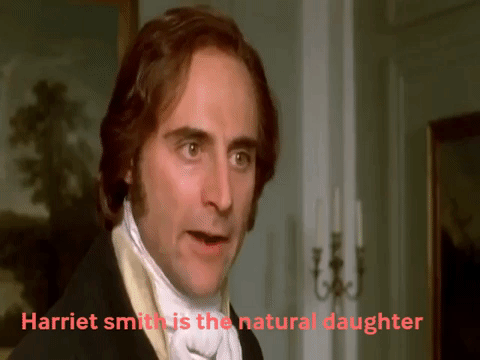
The final cherry on top is having Emma, after Knightley leaves the room with the last word firmly in his grasp, childishly pout “You are wrong Mr. Knightley, and you will see you are wrong and then you will be sorry.” I half expected her to cross her arms and stomp her foot. Worth noting is the fact that Davies adds an additional “It was badly done. Emma,” in this scene where there was none in the book. Rather overkill to my mind. Is this his catchphrase?
At Box Hill, Davies has Knightley begin his climactic rebuke of Emma’s insulting behavior by grabbing her arm and hauling her aside, and concludes by leading her, still holding her arm, to the carriage. Well at least he doesn’t shout at her in this scene; but again, all but one of Emma’s responses are cut out and she stands there, pouting until Mr. Knightley leaves and then she bursts into tears.
When Mr. Knightly proposes to Emma I was feeling good about this scene, until he dropped the “I held you when you were three weeks old” line, and I immediately felt uncomfortable. Maybe you DON’T want mention how you held her when she was a baby after you asked her to MARRY you. But perhaps worse is Emma’s response to the line: “Do you like me as well now as you did then?”
Bringing up holding Emma when she was three weeks old at the proposal (A line which was not in the book) is bad enough but there seems to be a peculiar repeated emphasis on Knightley recalling Emma as a baby. He dragged it up previously when he and Emma make up after the Harriet debacle, as he holds John and Isabella’s baby daughter (whose name, I would mention, is Emma.) In this instance too, the line is a Davies addition.
Let’s talk about Knightley’s strawberry line.
This is delivered in voice-over as a transition to the strawberry picking party at Donwell, and is portrayed as a formal invitation: “Mr. Knightley invites you to taste his strawberries, which are ripening fast.”
At first I was confident that I was reading too much into this (but I think at this point I can safely say that I’m not). I can’t help bursting out laughing every time I hear that line. It was a questionable way to word that if you ask me, especially considering that this is (once again) NOT the line in the book, and it was NOT a formal invitation. It was said to Mrs. Elton and intended to be a joke.
“You had better explore Donwell then,” replied Mr. Knightly “That may be done without horses. Come and eat the strawberries; they’re ripening fast.”
‘ If Mr. Knightly did not begin seriously, he was obliged to proceed so...’
And here I thought Janeites hated adaptations that cut out “Miss Austen’s biting wit.”
To top it all off, we have Frank Churchill (Who I have already pointed out is a bit of a creep in this adaptation and even more detestable than he already was as Austen wrote him) praising Jane: this would be fine, if he wasn’t drooling into Emma’s ear about the turn of Jane’s throat, (He actually utters this line)

and how fine his dead aunt’s jewels will look against her skin. May I just be the first to say “Ehewhegaugh”.
I juxtapose this with the book where Frank's lines are almost exactly as Davies renders them, except Jane Austen never wrote the "have you ever seen such a skin?" Line. The difference i have highlighted in bold:
"... She is a complete angel. Look at her. Is she not an angel in every gesture? Observe the turn of her throat. Observe her eyes as she looks up at my father. --- You will be glad to hear that my uncle intends to give her all my aunt's jewels. They are to be new set. I am resolved to have some in an ornament for the head. Will it not be beautiful in her dark hair?"
Because talking about how pretty your fiancee's hair is, is normal and marginally less creepy than talking about what a fine skin she has or how lovely your (i cannot stress this part enough) dead aunt's jewels will look against it. Davies' script also makes no mention of having them reset, which makes me think he’s talking about the actual necklaces and bracelets Mrs. Churchill would have worn.
But hey, maybe its just a me thing.
Harriet Smith’s story suffers, primarily, I can with some candor admit, due to the time constraints. After Mr. Elton is married, we never see Harriet in any distress. It’s almost as though she’s forgotten all about it! Emma never has to appeal to her to exert herself or to move on. Perhaps this is better than Doran Godwin’s Emma gaslighting Harriet and manipulating her by constantly chastising her for… well general heartbreak (but that’s a bugaboo for a different review.)
My last complaint of note is that ludicrous harvest feast at the end of the movie. The whole concept of this scene just does not seem at all Janely to me. I was under the impression that I was meant to be watching an Austen. Not some bullshit Thomas Hardy knock-off. This is another Davies touch and I hate it more on the principal that it is one of his numerous, obsessive tweaks made solely to point out the existence of the lower classes.
If Davies wanted to show Mr. Knightley’s being an attentive landlord and gentleman farmer then I don’t see why he couldn’t just show Knightley actually running his farm?
“Okay’, you might say, “but I think the highlighting of the servants is to show how good Knightley is by treating them like real people compared to everyone else”, and I hear you. And in the situations where that is the case, like him greeting the Woodhouse’s butler and asking after his family I think that’s totally fine and in character. But things like the servants moving the knee cushions every time someone moves down the line at strawberry picking, to me, is AS ridiculous as the “servants clipping the lawn on their hands and knees with tiny scissors” trope. Like we get it, people took the lower classes for granted, but I don’t think it’s a stretch to say that it would be easier and more realistic to have Mrs. Elton have to move her own knee cushion. I don’t think Knightley would instruct his servants, who he treats so well, to do that kind of thing, but you could write in Mrs. Elton’s expectation of it if you wanted. It seems like the kind of thing she would expect the landed gentry to do.
Screenwriter for some of the best loved Austen’s (including the sacrosanct 1995 P&P Mini-series and my favorite Sense & Sensibility), I thought of Davies for years as untouchable; until Sanditon happened and left everyone who knows anything about Jane Austen really wondering where this mess came from. I put it to you now that it was there in Davies all along.
Davies admitted, when talking about the drastic “Sexing Up” he did in Sanditon that he felt Austen’s works could have done with a bit more sex appeal. I can hardly disagree and additions like Darcy’s little swim in the pond and Edward Ferrars’ angsty wood-chopping are welcome and beloved. But it seems that what he really wanted all along was what he gave us in Sanditon; and finally, without actual source material to stand in his way, he had a chance let his dirty old man show and gave “Austen” the sexing up he thought it needed.
And it gets more troubling as you look back.
In my opening paragraph to this review I mentioned a 2008 blog post that not only agreed with me that there’s something very off about this screenplay, but gave me some possible insights as to why. It points out numerous things that I have always questioned in this version but have never seen anyone else criticize (though I am informed that more recently it has gained its’ share of critics). In fact the post itself actually points out that almost no one in the Austen Blog-sphere had (at that point) criticized this version’s faults in any meaningful way, but my favorite thing about it is that it points out what you find in Davies’ screenplay if you pay careful attention to it “Rather than sitting there and cataloguing what is “technically faithful and whatnot”.
Many Austen bloggers have kind of been playing Miss Taylor to Davies’ Emma for some two decades and change.
The most troubling thing of all is Davies own comments on Mr. Knightley (and other things, more inferred in his screen play). All of the aspects of this interpretation of Knightley that I mentioned earlier seem to stem from the fact that, as quoted in Sarah Caldwell’s book on his works, Davies thinks there’s “Something odd going on with Knightley.”
Davies clearly reads foul, or at least questionable, intentions in Mr. Knightley but I find it interesting that, rather than cutting out material he may have found troubling about Knightley in the book out of his screenplay, he doubled down by adding MORE troubling lines and situations (that were never in the book at all, and imagined solely by himself) in a romantic story with a happy ending.
Perhaps there’s not so much something odd going on with Knightley, Mr. Davies, but with you.
Final Thoughts
At this point I might ask what it is that everyone sees in this version that makes them think it’s so perfect, but that would be a bit pointless since all I’ve read since I discovered this version is people on elaborating on just that and I don’t care to hear much more.
“The lines are verbatim!” textually, perhaps, but it’s the ones that added that trouble me.
“The leads have so much chemistry!” I’m glad you think so, but I can’t find it.
“The costumes are damn near perfect!” And brown. So, so very brown.
As a 90's TV period drama, this version is pretty standard. It sticks to the book (except in those places where the screenwriter saw fit to dabble with some subtle but troubling suggestions about the characters.) And if it floats your boat, as always I'm glad it gives you what you want from the story.
I know I hold unpopular opinions on Jane Austen adaptations, and perhaps this is one of them, but every time I watch this version I feel the need to read the book as a cleanse. Perhaps Davies’s ferocious Knightley was simply a pendulum swing reaction to Douglas McGrath’s almost too laid back interpretation in the Miramax film from earlier in 1996, but even if that’s the case it’s just uncalled for and is my biggest turn off for this film.
Tone: 3
Ribbon Rating: Badly Done! (40 Ribbons)
Casting: 5
Acting: 6
Scripting: 4
Pacing: 2
Cinematography: 4
Setting: 3
Costumes: 5
Music: 2
Book Accuracy: 6
29 notes
·
View notes
Text
Jane Austen Takes
Tagged by @thelonelybrilliance thank you Emma I love your Austen opinions SO MUCH.
There is no particular order to any of these.
This hurts so much because there are SIX but here goes.
Five Favorite Heroines:
Elinor Dashwood
Elizabeth Bennet
Anne Elliot
Fanny Price
Emma Woodhouse
Five Favorite Heroes:
Darcy
Wentworth
Colonel Brandon
Knightley
Tilney
Five Favorite Villains:
Lady Catherine de Bourgh
That’s it! She’s so disgustingly funny and I get such a kick out of her.
I can’t even bring myself to put Lucy Steele here even though Lucy Steele is arguably THE WORST VILLAIN and Wickham is so slimy I don’t want to grace him with the “honor”.
I guess I like the absolutely garishly awful ones like John Thorpe and Augusta Hawkins and Collins—I laugh until I cry at their scenes, I really do. And they’re a PART of Austen’s underrated humor and understanding of people.
It’s just—this category is hard I plead the fifth
Five Favorite Sidekicks:
Harriet
Bingley
Jane
Margaret Dashwood (heavily influenced by the 95 version)
Collins (he’s also Too Funny and P&P would not be the same without his awfulness)
Five Favorite Scenes:
Pemberley Reunion scene
Knightley pressing Emma’s hand like that after the Box Hill fiasco has gone down and he’s leaving town to try to get away from Emma
Elinor cry-laugh-sobbing at the fact that Edward isn’t married. The RELIEF. Also it is in the book too! Though I think in the book she also runs out of the room.
Okay probably not “big” enough but when Catherine comes downstairs after crying her eyes out because Henry yelled at her and then it just says “he treated her exactly the same as he’d always done, only more gently” I DIE. Also when she runs up to him at the opera and is like “please don’t be mad please don’t be mad pleAse don’t be mad” and he thaws a tiny bit
The persuasion letter scene SPRINGS TO MIND but let’s say Wentworth making sure Anne gets a seat in the carriage for variety. I die.
Five Favorite Adaptations:
S&S 95
P&P 95
Emma ITV 96
Persuasion 95
?????????? Leaving this one open for when I watch the 80’s P&P
Five Favorite Underrated Things:
Mark Strong’s Knightley
Henry and Catherine in general
Anne’s conversation with Harville about the nature of men and women’s love. It means so so much to me. the letter only happens BECAUSE of that conversation.
Emma and Jane Fairfax’s conversations at the end of Emma, no I will not shut up about it, they are both beautiful and it is beautiful to watch Emma try so hard to be kind to someone she’s been callous about and it’s beautiful to watch Jane be warm and open when she’s been so cold. They’re both beautiful even if Jane is marrying The Worst Man Alive (it was that or be a governess so close call, i get it)
Edward Ferrars (I know I never include him on any favorite lists so I’m a hypocrite but I do like him and more importantly I like that he makes Elinor happy. I also do like that he won’t abandon Miss Steele. I mean on the one hand......DUMP HER. But Elinor isn’t wrong that it is admirable especially considering his family was so awful to her. He’s a slow-burn of a guy, it takes him a while to do things, but I love his gentleness and I love his quiet goodness and I love that certain stubborn faithfulness he has. He reminds me of Fanny.)
I tag: @themysciranprincessthings (nina DO IT) @misscrawfords @theofficestan and @ilovevanillatea
12 notes
·
View notes
Photo
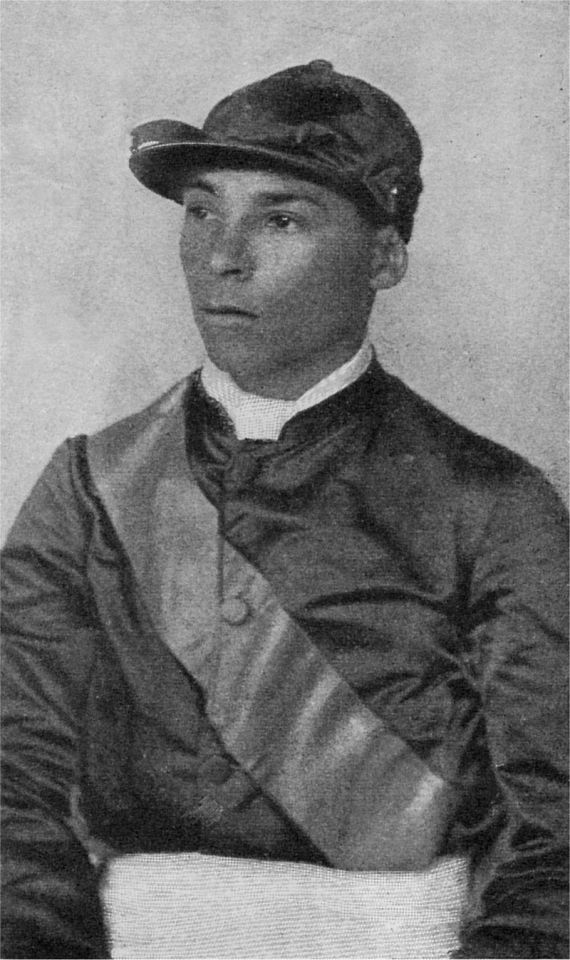
Celebrating Black History In 2020!
Willie Simms (1870-1927) - Only African-American Jockey to win the Triple Crown
Born (January 16, 1870, near Augusta, Georgia, U.S.—died February 26, 1927, Asbury, New Jersey), American jockey who is the only African American to have won all three of the races that compose the Triple Crown of American horse racing: the Kentucky Derby, the Belmont Stakes, and the Preakness Stakes.
Simms began racing in the North in 1887 and became the most-successful rider to adopt the short stirrup since the antebellum slave and rider Abe Hawkins. The short stirrup, which is now ubiquitous, lifts the rider over the horse’s withers (the ridge between the horse’s shoulder bones) and thereby allows the animal better balance. In 1895 Simms became the first American jockey to win in England. The short stirrup, however, earned more esteem after the white American jockey Tod Sloan used it to win English races in 1897, and it soon came to be known as the “American seat.”
Simms competed at a time when horse racing was dominated by black jockeys, who were the leading riders and often the highest-paid athletes of their day. African American jockeys won 15 of the first 28 runnings of the Kentucky Derby, the most-prestigious event in American horse racing, but they also faced much racial discrimination. Simms himself won the Derby in 1896 and 1898; he also won the Belmont Stakes in 1893 and 1894. When he won the Preakness Stakes in 1898, he became the only African American to win all the Triple Crown classics. Simms was the leading American jockey (on the basis of number of wins) in 1893 and 1894. When he retired in 1901, he had one of the best lifetime-winning percentages in the sport. By the 1920s, however, African Americans had been pushed out of prominent roles in horse racing, and the accomplishments of Simms and other African American jockeys had been all but forgotten. Simms was inducted into the hall of fame at the National Museum of Racing and Hall of Fame in 1977.
#black history month#Willie Simms#African American Jockey#Triple Crown#Kentucky Derby#Belmont Stakes#Preakness Stakes
3 notes
·
View notes
Note
Really enjoyed your JA Heroins and money post. Wanted to add that along with amount, origin was of importance. There was the distinction between old aristocratic money and new trade money. In P&P the Bingleys have new money. The guy from Emma who marries her nurse/companion at the start of the novel has new money. Lots of “concerns” about new money allowing the “lower classes” to obtain the same status and privileges as the aristocratic
Thank you! (this question references this post) And this is an interesting point, but I think it is far less black and white than new money just being "bad".
We know that both Lady Middleton and Mrs. Palmer (S&S) have fortunes from trade and they have both married well and are worth knowing socially. Mr. Weston (Emma), while having "new" money, is from a family that has been rising and he is allowed in Emma's circle of acceptable people. The Coles are not. Why? It's unclear. Have they risen too fast? Are their manners vulgar? Or is it that they haven't made it past the gatekeeper (Emma)? Emma is also very derisive of Augusta Hawkins's small fortune from trade.
However, the Bingleys do not seem to be looked down on at all. We are told they associate with people of rank and Darcy is happy to be friends with Bingley. It makes me wonder if they are from a gentry family and someone decided to go into trade? Or have they just made it past an Emma-esq gatekeeper? It's hard to tell.
Mr. Bennet marrying out of rank is clearly seen as a bad thing, maybe especially because his wife wasn't super wealthy or well-mannered. However, marrying a well-educated trade heiress seemed to be acceptable. Which makes sense if you have an estate you can never sell and you desperately need money.
Lastly, as much as Sir Walter in Persuasion detests the navy raising people above their class and the ideas of their forefathers, once Wentworth is rich, Elizabeth happily invites him to an evening of cards. So maybe this is something people were very frightened about in rhetoric but in real life they were more forgiving than their prejudices would suggest.
Which is to say, it seems like extreme wealth is a pretty strong and effective bleach for the "stain" of new money.
21 notes
·
View notes
Text
TOO MANY BATS
LOOK AT THIS MONSTROSITY I HAVE SPENT THE PAST SIX HOURS ASSEMBLING - THERE ARE ONE HUNDRED AND ELEVEN NAMES
(Follows the current Batman and new family members in order of appearance, their alter egos, their years of operation and ages. The Ultra Bomb Disaster of 2050 killed off a lot of superheroes, including twenty six of the active Gotham crimefighters, and also meant the remaining Bats took in a lot of orphaned meta kids who bolstered their ranks further with the next generation. Asterix symbol refers to someone returning to a uniform they wore previously):
Bruce Wayne (1997-2012) (22-37 years old):
Selina Kyle, Catwoman (1998-2023), Madam Cat (2023-2056) (22-47-80)
Dick Grayson, Robin (2000-2007), Nightwing (2007-2012) (10-17-22)
Barbara Gordon, Batgirl (2002-2008), Oracle (2008-2067) (15-21-80)
Jason Todd, Robin (2007-2009), Red Hood (2011-2039) (13-15, 17-45)
Tim Drake, Robin (2010-2012), Redbird (2012-2027), Bird’s Eye (2027-2048) (13-15-30-51)
Stephanie Brown, Spoiler (2010-2012), Batgirl (2012-18), Blonde Bat (2018-46) (14-16-22-50)
Cassandra Cain, Batgirl (2010-2012), Black Bat (2012-2050) (12-14-52)
Dick Grayson (2012-2014) (22-24):
Damian Wayne, Robin (2012-2020), Renegade (2020-2024) (8-16-20)
Colin Wilkes, Abuse (2012-2022) (9-19)
Kate Kane, Batwoman (2013-2025) (22-40)
Renee Montoya, Question (2013-2016) (23-26)
*Bruce Wayne (2014-2024) (39-49):
*Dick Grayson, Nightwing (2014-2026), Old Wing (2050) (24-36, 60)
Luke Fox, Batwing (2014-2048) (25-59)
Harper Row, Bluebird (2014-2015, 2020-2050) (14-15, 20-50)
Duke Thomas, Signal (2016-2050) (15-49)
Nell Little, Snitch (2017-2019), Spoiler (2019-2026), Snooper (2026-50) (12-14-21-45)
Tiffany Fox, Batgirl (2018-2025), Batwoman (2025-2050) (15-22-47)
Cullen Row, Agent C (2020-2091) (19-90)
Helena Wayne, Robin (2020-24), Batgirl (2024-27), Nightwing (2027-38) (11-15-18-29)
Mar’iand’r Grayson, Nightstar (2023-2050) (9-36)
Damian Wayne (2024-2038) (20-33):
Maya Ducard, Nobody (2013-2033), Shadowbird (2033-2063) (10-30-60)
Jake Grayson, Robin (2024-2030), Nightfire (2030-2050) (8-14-34)
Augusta Young-Gordon, Snitch (2025-2030), Spook (2030-50) (10-15-35)
Marigold Cain/Wayne, Batgirl (2027-2032), Gold Bat (2032-2050) (10-15-33)
Jasmine Todd, Robin (2030-2033), Catgirl (2033-39), Red Hood (2039-50) (12-15-21-32)
Jeremy Todd, Hoodlum (2032-2033), Red Bat (2035-2050) (12-13, 15-30)
Tawny Fox, Batgirl (2032-2037), Foxbat (2037-2048), Batwing (2048-) (13-18-29-)
Jack Drake, Robin (2033-2037), Redbird (2037-2050) (12-16-29)
Anne Drake, Spoiler (2033-2037), Batgirl (2037-42), Bird’s Eye (2048-) (12-16-21, 27-)
Richard Wayne, Impulse (2035-38), Dart (2038-45), Flash (2053-70) (10-13-20, 28-45)
Walter Brown, Spoiler (2037-43), Sparrow (2043-2050) (11-17-24)
Alf Wayne, Robin (2037-2045), Nightwing (2045-2050) (7-15-20)
Miguel Little-Reyes, Green Beetle (2037-2050) (13-26)
Helena Wayne (2038-2041) (29-32): (Yes, a girl can be Batman too)
Lyn Row, Harpy (2038-2050) (13-25)
Suze Bennett, Sphinx (2039-2050) (15-26)
Carmelita Little-Reyes, Snitch (2040-2043), Spoiler (2043-50), Snooper (2050-80) (10-13-20-50)
Sarah Wilkes, Ballpark (2040-2050) (16-26)
Louis Gibson, Flare (2040-2050), Signal (2050-70) (15-25-45)
*Damian Wayne (2041-2050) (36-46):
Helena Wayne, Catwoman (2041-2050) (32-41)
Melba Young-Gordon, Batgirl (2042-50), Batwoman (2050-70) (13-21-41)
Danny Wilkes, Cornerback (2043-2049) (15-21)
Tasha Teller Fox, Redwing (2043-2048), Foxbat (2048-2050) (19-24-26)
Luna Wayne, Robin (2045-2050), Batgirl (2050-60), Catwoman (2060-) (10-15-25-)
Alf Wayne (2050-2074) (20-44):
Haley~Harry Kent Grayson, Robin (2050-55), Nightwing (2055-65), Superman (2065-) (10-15-25-)
Corey Grayson, Nightfire (2051-) (10-)
Thyra Gardener, Black Ice (2051-) (13)
David Queen, Gold Bow (2052-2058), Green Arrow (2058-) (15-21-)
Sumi Brown, Spoiler (2052-2060), Batgirl (2060-63), Sparrow (2063-) (10-18-21-)
Cassidy Harper, Hawkgirl (2053-2063), Blackhawk (2063-) (10-20-)
Curt Batson, Superboy (2053-2063), Captain Marvel (2063-) (11-21-)
Sam Smith, Blue Tornado (2054-) (14-)
Mirabelle Hall, Snow Tiger (2054-) (15-)
Kelsey Todd, Robin (2055-2057), Catgirl (2057-2061), Catwoman (2061-) (14-16-20-)
Bethany Drake, Spook One (2055-2063), Redbird (2063-) (11-19-)
Beverly Drake, Spook Two (2055-2063), Batgirl (2063-2070), Batwoman (2070-) (11-19-26-)
Jett Todd, Street Rat (2056-2060), Red Hood (2060-) (13-17-)
Zaina Zatara, Stagehand (2056-2062), Zatara (2062-) (12-18-)
Rosa Reyes, Blue Beetle (2056-) (12-)
Robbie Hawkins, Spark (2057-2064), Static (2064-) (13-20-)
Terry McGinnis, Robin (2057-2061), Red Bat (2061-2074) (12-16-29)
Benjamin Drake, Kid Flash (2057-2070), Flash (2070-) (11-24-)
Joey Todd Allen, Kid Mercury (2058-2070), Mercury (2070-) (10-22-)
Vicky Logan, Menagerie (2059-) (16-)
Archie Bloomberg, Kid Devil (2059-2064), Red Devil (2064-) (13-18-)
Hanna Hawkins Wayne, Impulse (2059-2062), Silver Bat (2062-)(12-15-)
Ricardo Little-Reyes, Kid Lantern (2060-2062), Darklight (2062-) (13-15-)
Lucille Drake, Spoiler (2060-2065), Harpy (2065-) (15-20-)
June West, Spin (2060-) (11-)
Janus West, Twist (2060-) (11-)
Matt McGinnis, Robin (2061-2066), Redwing (2066-78) (12-17-29)
Dale Donovan, Animal Kid (2061-2065), Animal Man (2065-) (16-20-)
Liberty Free, Eve (2062-) (15-)
Angie Row, Sphinx (2062-) (15-)
Samantha Wilkes, Slamdunk (2064-) (15-)
Tom Wayne, Robin (2066-2070), Nightwing (2070-2085) (11-15-30)
Penny Wayne, Pigeon (2066-2070), Robin (2070-74), Greybird (2074-90) (6-10-14-30)
Maxine Gibson, Oracle (2067-) (21-)
Abby Brown, Spoiler (2069-2075), Batgirl (2075-2080), Snooper (2080-) (12-18-23-)
Maia Wayne-Queen, Speedy (2070-2076), Black Canary (2076-) (12-18-)
Terry McGinnis (2074-2078) (29-33):
Helen Kent-Grayson, Supergirl (2075-2085), Superwoman (2085-) (10-20-)
Sidney Hall-Smith, Blizzard (2075-) (14-)
Teddy Drake, Robin (2074-2076), Bluebird (2076-2090) (11-13-27)
Zeke Brown, Spoiler (2076-2085), Spook (2085-) (12-21-)
Iris McGinnis, Robin (2076-2078), Redwing (2078-) (9-11-)
*Alf Wayne (2078-2085) (48-55):
*Terry McGinnis, Red Bat (2078-) (33-)
Mason Todd, Robin (2078-2085), Stray (2085-) (11-18-)
Marisa Kent-Grayson, Nightstar (2078-) (10-)
Cici Batson, Gold Hawk (2079-) (13-)
Carson Batson, Marvel Kid (2079-2086), Olympian (2086-) (11-18-)
Toby Delmont, Roadrunner (2079-) (10-)
Darion Wayne-Queen, Gold Bow (2080-) (12-)
Bruce Kent-Grayson, Nightwing (2080-) (10-)
Riley Grayson, Starfire (2080-) (10-)
Finn Snart, Captain Cold (2080-) (19-)
Cera Little-Reyes, Green Beetle (2081-) (13-)
Vic Logan-Todd, Street Rat (2081-2085), Hybrid (2085-) (12-16-)
Scott Free Allen, Kid Mercury (2082-) (10-)
Tammy Row, Gryphon (2083-) (13-)
Remy Logan-Todd, Beast Boy (2084-2090), Beastial (2090-) (12-18-)
Tina Zatara, Conjure (2084-) (13-)
Sharise Hawkins, Spark (2084-) (15-)
Tom Wayne (2085-2090) (30-35):
Devin Wayne, Robin (2085-2090), Bluebird (2090-) (8-13-)
Shawn Wayne-Fox, Stopwatch (2085-) (12-)
Amara Drake, Red Beetle (2086-) (11-)
Kathy Row, Wyvern (2087-) (13-)
Ziva Zatara, Kid Devil (2088-) (12-)
Minnie Free Allen, Impulse (2088-) (10-)
Brian West, Kid Flash (2089-) (10-)
Penny Wayne (2090-) (30-): (Following in her great-aunt Helena’s example)
Martha “March” Snart-Wayne, Robin (2090-) (7-)
Valor McGinnis, Dart (2090-) (10-)
Selina Graysmith, Stormbird (2094-) (7-)
John Kent-Grayson, Superboy (2099-) (8-)
Joanna Todd, Cub (2100-) (10-)
Now, why did I put myself through this madness? Because I needed the full background prepared for my new story, HYPERTIME, starring March Wayne, Robin #26, and her cousin Lina Graysmith, the one and only Stormbird.
The multiverse is not prepared.
#Bats and Birds of Gotham#Hypertime Saga#fan fiction#bat family#those Waynes collect kids like there's no tomorrow#passing the torch#this isn't even everybody#only the active crimefighters#not the background support like Alfred and Leslie and Lucius#and their successors#but I can't be bothered to add more at the point#my neck hurts enough as it is
6 notes
·
View notes
Text
Austen sims chaos
Some more from our first little meet and greet with the Austen gang.
I wonder if it’s too late for me to add Isabella and John Thorpe from Northanger Abbey to the mix? I feel bad for Northanger Abbey only having 2 characters from it, and they’re a fun pair... but personality-wise both very similar to Henry and Mary Crawford... hmm.
Here we have Frank Churchill asking Frederick Wentworth what it’s really like being a sailor, and if you all have to wear eyepatches like pirates.


Not sure why George Knightley is so upset - the gorgeous Jane Fairfax certainly thinks he’s hot stuff.

Caroline Bingley had just finished arguing with Lizzie Bennet, so you’d think Fitzwilliam Darcy was coming to tell her off for it - but actually Darcy hates Caroline so much he just stalked her constantly around the lot ready to fight.
Also that’s George Wickham charming Anne Elliot just behind...

Emma Woodhouse and George Wickham had a fabulous water balloon fight together while everyone else was causing drama,

Lizzie Bennet and Jane Fairfax - yep, I support this ship!

Poor William Collins did nothing but cringe at his own failed jokes over and over, including to Charlotte Lucas here.

But if you fail once, try, try again (Charles Bingley really couldn’t bear his bad jokes).
Mind you, everyone was ACR back-rubbing, flirting and romantic-hugging each other, and there’s a gazillion 3-bolters, so I’m not paying much heed to any of it just yet.

Eventually I locked Caroline inside by herself as I couldn’t kick her out of her own uni house - Darcy wouldn’t stop poking her rather than socialising with anyone else, and Caroline wouldn’t stop bullying absolutely everyone, including Henry Crawford here. She has a particular talent for annoying those she 3-bolts with.

Emma Woodhouse either knows John Willoughby is a rake and is angry on Marianne Dashwood’s behalf.... or wants him for herself!
And now, for those who are interested, here are the initial mutual 3-bolters (warning, there are a great deal):
Caroline Bingley and Fitzwilliam Darcy (they also really hate each other...)
Caroline Bingley and William Collins
Caroline Bingley and John Willoughby
Caroline Bingley and Henry Crawford
Caroline Bingley and Philip Elton
Caroline Bingley and George Wickham
Caroline Bingley and Frederick Wentworth
Charles Bingley and Kitty Bennet (although he also hates her for beating him up!)
Charles Bingley and Lydia Bennet
Charles Bingley and John Willoughby
Charles Bingley and Henry Crawford (he has dreadful taste)
George Wickham and Lydia Bennet
George Wickham and Kitty Bennet
George Wickham and Mary Crawford
George Wickham and Augusta Hawkins
Georgiana Darcy and Christopher Brandon
Georgiana Darcy and James Benwick
Georgiana Darcy and Lizzie Bennet (!!)
Georgiana Darcy and Edmund Bertram
Georgiana Darcy and Jane Fairfax
Georgiana Darcy and Edward Ferrars
Georgiana Darcy and John Willoughby
Georgiana Darcy and George Knightley
Georgiana Darcy and Henry Tilney
Georgiana Darcy and Mary Bennet
Georgiana Darcy and Catherine Morland
Jane Bennet and Christopher Brandon
Lizzie Bennet and Edmund Bertram
Lizzie Bennet and Henry Tilney
Lizzie Bennet and Jane Fairfax
Lizzie Bennet and James Benwick
Lizzie Bennet and Christopher Brandon
Lizzie Bennet and Edward Ferrars
Lizzie Bennet and George Knightley
Mary Bennet and Edmund Bertram
Mary Bennet and George Knightley
Mary Bennet and Christopher Brandon
Mary Bennet and Jane Fairfax
Mary Bennet and James Benwick
Kitty Bennet and Henry Crawford
Kitty Bennet and John Willoughby
Kitty Bennet and Frank Churchill
Kitty Bennet and Mary Crawford
Lydia Bennet and Henry Crawford
Lydia Bennet and John Willoughby
Lydia Bennet and Frank Churchill
Emma Woodhouse and Henry Crawford
Emma Woodhouse and John Willoughby
George Knightley and Fanny Price
George Knightley and Marianne Dashwood
Frank Churchill and Henry Crawford
Frank Churchill and John Willoughby
Jane Fairfax and Edward Ferrars
Jane Fairfax and Edmund Bertram
Jane Fairfax and Marianne Dashwood
Jane Fairfax and James Benwick (she’s furious with him, and I have no idea why)
Jane Fairfax and Christopher Brandon
Jane Fairfax and Henry Tilney
Augusta Hawkins and Philip Elton
Augusta Hawkins and John Willoughby
Augusta Hawkins and Henry Crawford
Robert Martin and Harriet Smith
Robert Martin and Elinor Dashwood
Anne Elliot and James Benwick
Anne Elliot and Edward Ferrars
Anne Elliot and Edmund Bertram
Anne Elliot and Christopher Brandon
Anne Elliot and Henry Tilney
Anne Elliot and John Willoughby
James Benwick and Fanny Price
James Benwick and Marianne Dashwood
James Benwick and Henry Tilney
James Benwick and Elinor Dashwood
Fanny Price and Edmund Bertram
Fanny Price and Edward Ferrars
Fanny Price and Christopher Brandon
Fanny Price and Henry Tilney
Edmund Bertram and Elinor Dashwood
Mary Crawford and John Willoughby
Henry Crawford and John Willoughby
Catherine Morland and Henry Tilney
Catherine Morland and John Willoughby
Henry Tilney and Marianne Dashwood
Henry Tilney and Elinor Dashwood
Henry Tilney and John Willoughby
Elinor Dashwood and Edward Ferrars
Elinor Dashwood and Christopher Brandon
Marianne Dashwood and Christopher Brandon
Marianne Dashwood and John Willoughby
John Willoughby is by far the most popular sim, with 14 mutual 3-bolts! I’ll see how that all changes once I start properly playing them though - I hope they don’t just end up with the 3-bolters they live with, that’s no fun. Will have to throw many parties!
16 notes
·
View notes
Text
Brooksville, Florida

Quick Brooksville, Florida History
Brooksville, Florida was originally known as Melendez and then Benton. Incorporated in 1856, it is a wonderful city featuring a hilly terrain that ranges in elevation from 175 to 274 feet. There is a long history of successful planters, growers, and cattlemen in and around Brooksville.
Its southern background is reflected in its name, honoring South Carolina Congressman Preston Brooks who is best noted for hitting abolitionist Senator Charles Sumner on the head with his cane.
Brooksville's downtown area features the iconic Hernando Courthouse, along with great shopping in unique stores featuring everything from antiques, outfits, high-end resale, stationery, flowers and bric-a-brac to formal gowns – and stationery. Some streets still show the Augusta bricks laid by hand.
Florida Wildlife Corridor Foundation mural painted by Justin Alsedek is on Brooksville's City Hall building, which houses a free art gallery upstairs.
Things to Do in Brooksville, Florida
There are several downtown restaurants and coffee shops, along with legal and banking offices, a library, and more than one park. Brooksville has been working hard to revive its downtown to attract more visitors and became a Florida Main Street community in 2016.
For those looking for things to do in Brooksville, the Main Street organization holds several events in Brooksville's downtown area as well as farmers and artist markets, and a simply magical holiday celebration of all things Christmas during December with everything from musical trees to performing artists, decorations galore and horse-drawn carriage rides.
Local art is displayed in several downtown businesses and buildings, as well as murals painted throughout the downtown area. A walking tour map of the downtown murals may be found here.
The Brooksville City Hall building houses a changing art exhibit in Gallery 201, and all are welcome. There is no charge.
The architecture is interesting in several buildings and when looking for things to do in Brooksville, Florida, a wonderful historic walking tour can be had for the simple act of following the map here. If you would like more information about each building on the historic tour, download the complete guide here. (Please note that the Hernando Chamber of Commerce has moved to Brooksville's Tampa Bay Regional Airport. The guide is dated, but the history and map are accurate.)
Historic homes are throughout the downtown area and a tour has been mapped out. There are two B & Bs, including this one, known as the Mirador.
Another popular thing to do in Brooksville, Florida, is to visit the May Stringer Museum, located at 600 West Jefferson. Housed in the 1850 Stringer House, a Queen Anne masterpiece with a four-story tower, this historic building is reputed to be haunted. There are daily tours Tuesday - Saturday led by docents and the price of admission is only $10 for adults, $5 for children, free for those under 6 years of age, but the exhibits seem more adult-friendly.
F. L. Stringer was a State Senator and judge. With thousands of historic artifacts and regular tours, it commemorates the Civil War era and provides a glimpse at the lifestyle and relics of a gone but not forgotten segment of American history. Ghost tours are held on Friday and Saturday nights by reservation.
The May Stringer House houses a historical museum that is well worth a tour in Brooksville. It is said to be haunted.
In addition to the May Stringer house there is a historic train depot to visit. Next to the historic train depot museum is a one-room schoolhouse to visit on Russell Street. Both of these museums are adjacent to Russell Street Park which has the Good Neighbor Trail running through it.
The Good Neighbor Trail is a paved, multiuse trail that runs about 10.3 miles to connect with the Withlacoochee State Trail.
Continue east to find another wonderful shopping area, featuring the Hawkins House and the Florida Cracker Trading Company and Tap Room. There is even an old-fashioned Coney Island where it is rumored that Elvis Presley may have eaten many years ago with an ice cream shop in front.
The Florida Mermaid Trail
In 2020, a Mermaid Trail was created in downtown Brooksville, which is part treasure hunt and part walking tour. It is an easy activity for one or more to get out and enjoy the historic brick streets and well-kept homes and businesses. Each February, a Mermaid Festival is held in Hernando Park, where residents and visitors compete for the best-dressed mermaids, with and without their pets, and meet the real mermaids of Weeki Wachee Springs State Park. The maps for the Mermaid Trail can be found at Florida's Adventure Coast Visitor Center, adjacent to the park.
Expanding Beyond Brooksville’s City Limits
You may want to travel north on US 41 to visit the historic Chinsegut Hill Historic Site and rediscover the magic that caused its last private owners to name it Chinsegut, meaning, “a place where lost things are found.” Learn their story of courage and civil rights for all, as well as a historic timeline of occupation during significant national events. And it's beautiful and somewhat magical.
*Please note that Chinsegut Hill Museum is managed by the Tampa Bay History Center and is open on weekends for tours, as well as some outdoor events on select weekdays. An Emancipation Celebration is held in May.
Originally constructed in the early 1800s, and then added onto by subsequent owners, the Chinsegut Manor House was renovated in 2013-2014 and has been restored to the splendor of its glory days. Image by Diane Bedard.
Don't forget the Ice Cream
Head back south on U.S. 41 and then travel east on S.R. 50/U.S. 98. Make a right on Spring Lake Highway (541) and follow it to the top of the hill. On the right is Boyett’s Grove Citrus and Timeless Attraction. Here you will find a wonderful animal park where you can feed the animals, a dinosaur cave, taxidermy museum, birds, snakes, an alligator named, "Elvis", and more.
A putt-putt golf course winds through part of this fun-filled tourist trap. There’s even a snack bar, ice cream parlor, and an old-fashioned Florida gift shop! It’s one of my favorite places on the Nature Coast.
Read the full article
0 notes
Text
The Steele Family Album: Volume II (aka Love & Freindship)

William Collins displays hitherto unsuspected talents! Maybe he should have gone into Entertainment rather than The Law?

Little Catherine gets picked up off the floor long enough to age up! (Why does my game love this hair so much for toddler girls?)
~ Aries 6 / 5 / 5 / 6 / 6
~ Ambitious / Perceptive

And Lucy continues to demonstrate very little aptitude for parenting - isn’t it lovely to see such a supportive environment for the little ones?!

Fortunately, Nancy grows up relatively unscathed - even if she is turning out to be one of my least personable Sims!
~ Scorpio 10 / 6 / 8 / 2 / 1
~ Devious / Anxious / No Sense of Humour
~ OTH: Fitness
~ Favourite Colour(s): Pink

However, at least she’s now big enough to get her own breakfast, which is an essential skill in this household.

Ah, the exuberance of youth!

How cute! I didn’t know that adults could play with the dollhouse along with the kids. :)

A life of crime might not have been Lucy’s first choice of profession, but actually she’s doing rather well in it, and has become chummy with colleague Melissa Fancey (whose attire is certainly most apt).

Meanwhile, Nancy has befriended Townie kid Orlando Bertino.

William loves a party, so he gathers everyone that he knows to celebrate Catherine’s birthday. It’s certainly a very jolly affair, with several gate crashers!

Happy birthday, Catherine!
~ Aries 6 / 5 / 5 / 6 / 6
~ Ambitious / Perceptive / Green Thumb
~ OTH: Science
~ Favourite Colour(s): Blue

And then it all descends into chaos, when Augusta catches Philip foolishly sneaking a kiss with Caroline in the kitchen!

For reasons not satisfactorily explained this sparks a full-on fistfight between William and Harriet Smith (who wasn’t even invited)! Come on, you lot, it’s a kid’s birthday party, for goodness’ sake!

John Willoughby and new acquaintance Melissa Fancey escape the melee in the kitchen for a bit of a boogie in the living room.

Lucy and Henry Crawford opt for a quiet catch-up in the bedroom - all perfectly innocent, they just decided to hang out together on the bed!

The kids remained blissfully unware of the drama that ensued at the party, and in the aftermath are more interested in developing their own friendships. Level-headed Clara Dashwood seems an unlikely friend for crazy mixed-up kid Nancy, but we’ll see! Catherine and Gabriel Smith (yet to be introduced) are getting along famously, however.

Catherine’s also become very fond of stray moggy Moonshine, who is still touring the neighbourhood. But he seems very picky - he hasn’t yet chosen a family to move in with. (Seriously, how do you get strays to move in?)

William also has a new friend. Townie Marisa Bendett is often to be found hanging around the house, and seems to have developed an unaccountable obsession with William. I’m not sure whether she’s just looking for friendship, or maybe something more...

Definitely something more! But is William naively oblivious to her intentions, or is he willingly playing along?

Lucy’s solid friendship with George Wickham remains entirely platonic - and he pops by just to do a bit of gardening for her.


Unfortunately, there’s no love lost between the girls - Nancy’s favourite pastime is tormenting her younger sister. (And yes, I’ve now realised that I goofed up the placement of the fireplace in the living room!)

Even though his daughters are quickly outgrowing the dollhouse, it’s still just as popular with William!

Catherine’s efforts to entice Moonshine to join the family have sadly come to nothing, so she finally gets her birthday wish, and the family adopts a kitten - hello, Tiberius!
#sims 2#gameplay#merybury#steele family#lucy steele#william collins#nancy steele#catherine steele#tiberius steele#augusta hawkins#philip elton#caroline bingley#harriet smith#john willoughby#henry crawford#george wickham#clara dashwood#gabriel smith#melissa fancey#orlando bertino#marisa bendett#moonshine the stray
36 notes
·
View notes
Photo
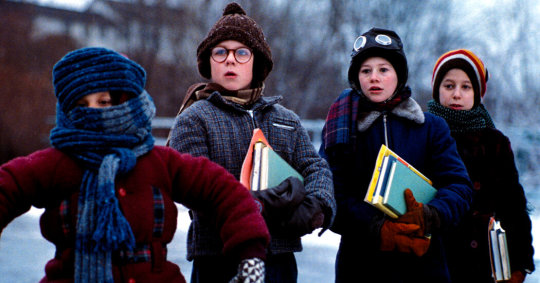
New Post has been published on https://freenews.today/2020/12/05/geek-out-over-christmas-films/
Geek Out Over Christmas Films

Theaters would normally be packed this time of year with folks assembled to watch revered holiday films like “It’s a Wonderful Life,” Frank Capra’s 1946 heart-tugger usually returns to big screens over the holidays, including an annual weeks-long run at the IFC Center in New York.
But with many theaters now dark, fans in search of a more communal experience have been forced to get creative.
Here are some (mostly) digital ways to expand the magic of classic Christmas cinema right.
‘It’s a Wonderful Life’
An annual festival goes virtual at the 10-year-old It’s a Wonderful Life Museum in Seneca Falls, N.Y. This year the museum celebrates the 74th anniversary of this treasured film.
Friday through Dec. 13, there’s a jam-packed calendar of online events. Among the highlights is a series of chats with three actors who played Bailey children: Karolyn Grimes (Zuzu), Carol Coombs Mueller (Janie) and Jimmy Hawkins (Tommy). Jeanine Roose, who portrayed young Violet and is now a psychologist, anchors a discussion called “Having ‘A Wonderful Life’ During the Pandemic.” There’s also an “Auld Lang Syne” singalong and an “It’s a Wonderful Life” watch party on Zoom. (Stream the film on Amazon Prime, but for the love of Christmas, avoid the colorized version.)
Christmas Con
Comic Con but for Christmas: That best describes this fan convention dedicated to all things holiday, with an emphasis on the sweet-as-candy-cane rom-coms that rule Lifetime and the Hallmark Channel.
There will be online meet-and-greets and chats with several popular actors, including Melissa Joan Hart (“Holiday in Handcuffs”) and Joey Lawrence (“Hitched for the Holidays”). Panels will be moderated by Jacklyn Collier and Shawlini Manjunath-Holbrook, the hosts of the Hallmark Channel’s Bubbly Sesh podcast. Kids can schedule a virtual visit with Santa.
Over 9,000 people attended Christmas Con last year, according to Christina Figliolia, a co-owner of Thats4Entertainment, which organized the event. Figliolia said she planned a digital pivot this year after hearing from fans early in the pandemic.
“We had to go virtual. It just means too much to so many people,” she said.
‘A Christmas Story’
This 1983 family comedy about young Ralphie Parker and his frenzied quest for a Red Ryder air rifle is the Christmas movie for many families.
For a more immersive experience, the Christmas Story House and Museum, located in Cleveland’s Tremont neighborhood, offers tours and overnight stays in the house where parts of the film were shot. (Mask requirements and other pandemic protocols are in effect.) Its online gift shop will ship fan merchandise like leg lamps and pink bunny suit pajamas.
The museum’s website also hosts a 24/7 online livestream that gives viewers a bird’s-eye view of the house. When a Cleveland snowstorm hits, the camera offers fans an almost cinematic vista.
‘White Christmas’
This year brings two new ways to enjoy this 1954 musical romantic comedy starring Rosemary Clooney, Bing Crosby, Vera-Ellen and Danny Kaye as a group of entertainers who try to save a failing Vermont inn during World War II.
A new exhibition at the Upcountry History Museum in Greenville, S.C., features original costumes, props and memorabilia from the film, much of it from the permanent collection at the Rosemary Clooney House in Augusta, Ky.
Short videos about the exhibit are on view for free on the museum’s Instagram and YouTube channels. Among the highlights are Edith Head’s shimmering blue dresses she designed for Clooney and Vera-Ellen to wear when they sang the sassy number “Sisters.”
For a big screen experience, head to Chicago, where the Music Box Theater is presenting “White Christmas” (and “It’s a Wonderful Life”) on several dates from Friday through Dec. 24 at the Chi-Town Movies drive-in. Each outdoor showing kicks off with a Christmas carol singalong.
Source
0 notes